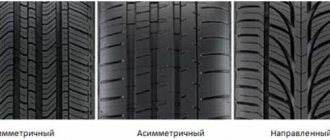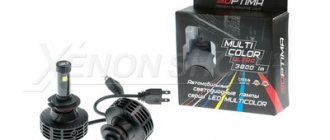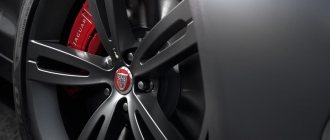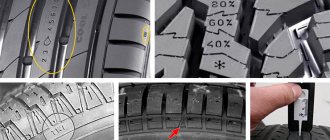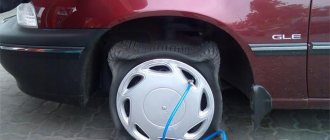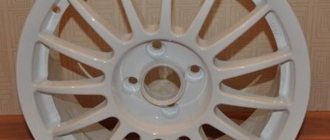When buying new tires, you should definitely look at the markings on the side surface. She will help you purchase the most suitable tire that meets all your requirements. The marking of car tires has long been standardized, and there is nothing complicated about it. Let's look at the decoding of notations that may appear; they are easy to remember.
Manufacturer and trade line
It’s hard to go wrong with this – tire manufacturers put their name in a prominent place. If they have a logo, it is usually very visible too. There are a lot of manufacturers, so you shouldn’t focus only on this indicator, unless you need a specific brand.
In addition, each manufacturer usually has trademarks and lines within which tires with certain parameters are produced. Knowing this information, you can immediately select the right tires. If the name of the line from a specific manufacturer is unknown, you will have to select according to individual parameters, using the markings and decoding of their designations.
Size
This is one of the most important characteristics of any tire, which is what any car enthusiast pays attention to first. But, judging by eye, it’s easy to make a mistake, so the tire sizes should be looked at on the tires themselves.
For example, a tire designated 185/75R16C has an inflated tire width of 185 mm. This width is measured between its side surfaces. The number 75 is an indicator that shows the profile height as a percentage of the width. This is the distance from the rim to the top of the tread. In our example, the height will be 185 * 0.75, that is, 138 mm.
Example of marking 225/45ZR17 with profile height 101 mm
The letter R is a design index that means the radial type of tire, from the word Radial. This is the most common type now. The number after the letter R is the diameter of the rim in inches that this tire fits.
The letter C in this designation indicates that the tire is reinforced and can be used, for example, on minibuses.
That is, even if you already understand what the 185/75R16 type marking means, you will be able to choose tires of the desired width, height, and the desired wheel size.
But the height is not always clearly marked, so you just need to know that in this case it is a percentage of 0.8-0.82 of the width. If the ratio is different, then it is indicated.
Sometimes the problem arises of how to correctly read the markings of tires made in the USA, for example, this one - 35/12.5R15. Everything here is approximately the same, only the dimensions are indicated in inches, and 1 inch is equal to 25 millimeters. The first number means the full diameter of the tire - 35 inches, the second 12.5 means the width, also in inches. R15 means the diameter of the rim in inches.
Tire size: what the numbers mean and how to read them correctly
The marking of car tires consists of several meanings. For example, on any wheel the manufacturer, brand of rubber, and tire size are indicated. The first three numbers on the wheel indicate the size of the rim (in inches, 1 inch equals 2.54 cm), how wide the tire is, and the profile height. This marking can be seen if you look at the wheel from the outside.
Let's look at what the numbers on tires mean using a specific example of a wheel marked 195 60 R16. The first number 195 mm is the tread width. What does the second number in the tire marking mean? It shows the relationship between tread height and tire width. The wheel will cling to the surface perfectly if the value of this index is high. Most often, drivers call this parameter profile height.
The last number indicates the inner diameter of the tire (in inches). Many car owners make this mistake: they buy tires without taking into account that the external parameters change.
So, the height of two wheels marked 185 65 R15 and 210 65 R15 will be different, but the landing diameter will be the same. Due to small differences in profile height and tire width, in this example it will be impossible to mount the tires on the car. This should not be forgotten when purchasing a set of wheels. To find tires with the appropriate size, you can use a tire calculator.
In addition, there is one more parameter marked on any wheel, this is the permissible speed. It is located after the numbers on the tires indicating the tire size. This index means what maximum speed the tire is designed for.
What do the numbers on tires after the speed index mean? Usually the permissible load on one tire is indicated there. For example, it may look like this: “88T”. This figure means that when driving at the maximum possible speed of 190 kilometers per hour, the load on one wheel should be no more than 560 kilograms.
Maximum load
The load index is designated as Load Index, and is usually applied next to the previous parameters. This is a code that shows what maximum load a tire can withstand. The numbers themselves do not express this load - they are just a code.
So, in our example, this index is designated as 104/102. This means that the tire can support a weight of 900 kg. (index 104) alone, and if it is paired with another wheel, then 850 kg. (index 102).
The permissible load on a wheel can be calculated by dividing the total weight of the car by 4, that is, by the number of wheels. But we must remember that rubber must be purchased with a safety margin - approximately 20%, and for SUVs - 30%. Otherwise, it will constantly work at the limit of its capabilities and not only will it wear out quickly, but the tire may explode while driving, and this is very dangerous.
But you shouldn’t have too much safety margin either, otherwise such a tire will not only be more expensive than what you need, but also much heavier. As a result, fuel consumption will increase and dynamics will deteriorate.
Do not confuse the load index, which is designated by a special code, and the maximum permissible load, which is designated as Max Load. But this parameter is indicated immediately in kilograms or pounds - do not confuse it. 1 pound is equal to 0.45 kilograms. The units depend on the country in which the tires for the car were produced.
But all this applies to ordinary, standard tires. But sometimes they are marked XL. What does it mean? This is how special, reinforced tires are marked, made from more durable material or using additional structures. Outwardly, they are no different from ordinary ones, but are able to withstand increased load. They are used for crossovers, small trucks and on rough roads where tire wear is greater.
What do the numbers on car tires made in the USA mean?
On American tires you can find two different types of markings that differ from each other.
Let's consider the first marking: P 195/60 R 14 or LT 235/75 R15. As you can see, it is practically no different from the European one. However, the size is preceded by the letter P on passenger tires or LT on tires for light trucks.
There is also a second marking, it looks different: 31x10.5 R15. In this case, the usual European marking would look like this: 265/75 R15. What do the numbers on tires with this marking mean (in inches):
- 31 — outer diameter of the tire;
- 5 - the number means the width of the wheel;
- R - the letter means that the tire has a radial design. Initially, rubber was produced with a bias construction, but this method of making tires has become outdated;
- 15 - this number means the inner diameter of the tire.
It is worth noting that if you do not pay attention to the units of measurement (unusual inches), then the American markings will be clearer and more logical in comparison with the European ones. Indeed, in the second case, the height of the rubber profile depends on the width of the wheel. In American labeling, everything is simpler. For clarity, let’s look at what the first number in tire size means. It shows the standard size, that is, the outer diameter. The second number indicates the width, the third indicates the internal diameter.
How to find out the width of a tire in our usual units of measurement, that is, in mm? To do this, you need to multiply the width in inches 10.5 by 25.4, because one inch equals 2.54 cm. The result is 267 mm. Since this size is not available, we take into account the width of the tire 265, which is obtained after rounding.
The next step is to find out the height of the sidewall, which is measured as a percentage. To do this, we perform the following steps: subtract the bore diameter from the outer diameter. Then we divide the resulting value by 2. The figure we get must then be divided by the width of the profile.
We recommend
“Cleaning fuel injectors for smooth engine operation” More details
Thus, in our example we have the following: ((31 - 15) : 2) : 10.5 = 0.76. The resulting value must be rounded to 75. As a result, we will have the following markings on the tires: 265/75 R15.
If the profile height is not indicated on the tire, do not forget that for passenger tires this figure is 80–82%, for truck tires 88%.
To convert from the metric to the inch system we will need to perform calculations:
- Find the diameter by multiplying the tire width of 265 mm by the profile height of 0.75. Then multiply the resulting value by two. As a result, you will get 397.5. It should be converted to inches (divided by 25.4), and then added to the wheel diameter: 15.6 + 15, you get 30.6. To make it more convenient, you need to round the number up. At the end of some simple math, you will find the tire diameter in inches.
- How to determine the width of a tire in inches? To do this, divide the width in millimeters 265 by 25.4. We get a value of 10.4 inches.
So, we figured out what the numbers on tires with the American marking 31 * 10.5 R15 mean
Speed index
The marking of tires for passenger cars usually also includes a letter. In our example, it looks like 185/75R16 104/102S. We've already figured out the numbers, but what does the letter S stand for? This is the speed index, which indicates the maximum permitted speed with maximum load. If this speed is exceeded under such a load, the tire may simply not withstand it.
The speed index is indicated in Latin letters. If it is F, then the speed is limited to 80 km/h, if J – to 100 km/h. The letter S in our example limits the speed to 180 km/h.
There are tires on sale labeled ZR, and car enthusiasts often do not know what this means. This is just a radial tire with a permissible operating speed of up to 240 - 300 km/h. Although now a single-letter designation system is used, and there are letters W (up to 270 km/h) and Y (up to 300 km/h) for this range.
Additional markings
Among other things, there are a number of additional markings on the tires. Below is a breakdown of the inscriptions most often found among tire manufacturers.
- The production date is indicated by a four-digit number on the profile rim. The first two digits are the serial number of the week in the year. The second is the year itself. That is, the number 4012 signals that the product was produced in the 40th week of 2012;
- sometimes you see the word “outside” on the tire. This means that the product has an asymmetric tread and installation is carried out with the inscription facing outwards. If this designation is absent, then the side does not matter;
- DOT or ECC markings indicate compliance with the parameters of Western GOST in its American or European manifestation;
- The inscription Reinforced means the same reinforced composition as Extra Load. Such reinforced rubber can have up to 6 layers, and if the letter “C” is added at the end, then their number can increase to 8;
- the presence of an umbrella-shaped pictogram or the letters Rain/Water/Aquatred indicates improved tread drainage and better performance when driving on wet surfaces;
- special TWI marks indicate the presence of a tire wear indicator. The marks are located in various places on the tire and indicate wear. The last notch is made at 1.6 mm - the minimum tread height. Thanks to this, you can determine the exact time to replace a set of wheels;
- Tubeless – designation of tubeless tires;
- RunFlat - some manufacturers have a special designation for tires with a rigid sidewall. This design allows the driver not to have a spare tire at hand. In the event of a puncture, tires can travel 80 kilometers at speeds of up to 80 km/h without causing damage to the rim or the rubber itself;
M+S (Mud+Snow) - all-season tires with a more developed tread that provides traction in bad weather conditions.
Purpose
Rubber varies in purpose, and this is indicated before the size. The following designations are found:
- P – passenger cars.
- LT - small trucks.
- ST – trailers.
- LRO – low platform trailers.
- T – temporary options, used only for spare parts.
These requirements must be observed, since their characteristics are very different, and using them for other purposes will not lead to anything good.
Sometimes tires have the SUV designation on them, while others don't. This abbreviation means Sport Utility Vehicle, that is, these tires are intended for all-wheel drive SUVs. It has increased strength and other characteristics that allow it to work with increased load. Owners of SUVs need to purchase tires with this mark, but they also vary, both in size and according to seasonal restrictions.
Seasonality
The marking of tires for passenger cars also has designations indicating its purpose. They may differ from one manufacturer to another. For example, in Europe they put the letters M+S, which means Mud + Snow, that is, “dirt + snow.” For Europe these are winter tires.
Example of tire designation “Mud + Snow”
There are other marks that may have a similar meaning:
- AS - all-season tires.
- AGT – also all-season
- R+W – for winter roads.
- Frost – winter.
- AW - all-weather.
- A/T – for any terrain.
- M/T – you can ride in mud.
But not all manufacturers use such abbreviations. There may be designs in the form of rain, sun and snowflakes - on all-weather tires, or mountains and snowflakes - on winter tires.
There are also rain tires, they may have the inscription Aquatred, Water, Rain, or simply Aqua on them. Sometimes there is an umbrella on the side instead.
Main tire size decoding on car wheels
For many drivers, deciphering tire markings turns out to be a difficult task; not many people have an idea about the many different symbols. However, the information on the sidewall of the tire is useful and important, and in some situations necessary. For example, at the time of purchasing winter tires for a car.
View the tire clockwise.
- The Latin letters M+S and the pictogram designation give an understanding of seasonal use and weather conditions. snow + mud
- The numbers are the tire dimensions: profile width/percentage of the ratio of height to profile width, the letter R is the tire type, the next value is the rim diameter (indicated in inches).
- The following shows the maximum load level and the permissible maximum speed.
R - radial design - The term "Rotation" accompanied by an arrow indicates the direction of rotation of the tire while the vehicle is moving forward.
bus directions - TWI – location of the wear indicator.
- Temperature and braking indicators.
two letters “AA” is a good indicator of braking - Date of manufacture of the tire, where the first 2 digits are the week, the next 2 are the year. For example, 0318 – 03 week, 2021.
week and year - A letter and number in a circle indicates compliance with the standards. Code of country of assembly and regulations.
E - European standard. 4 - Netherlands - The next mark is the design index.
- Large letters and numbers – manufacturer.
- The terms “INSIDE”/“OUTSIDE” are the external and internal sides, respectively.
- “MAX LOAD” + numbers – indicator of the maximum load (kilograms, pounds) at the indicated pressure.
- Color mark.
opposite they put a nipple for balancing - The following is information about the design.
What do the markings on tires mean: tubed and tubeless?
In terms of external characteristics, the types of tires do not differ, so each of the varieties received a special marking.
The corresponding mark in the form of Latin letters or words is located on the side.
Tubeless tire: T, TL, TUBELESS.
Tube tire: TT, TUBE TYPE or no marking.
The two types of tires differ in design, weight, and repair method.
Additional tire size markings and their meaning
Consider the example 205/75 R15 91 T XL
- 205—width in mm.
- 75 - profile, percentage ratio of profile height to width. (75%). The lower this indicator, the lower the tire will be.
Profile is a relative indicator. If a tire of size 205/65 R15 is replaced with 195/65 R15, the tire, tire and height will decrease. Most often, such a replacement is unacceptable. Check the permitted sizes in the machine's operating instructions. It is convenient to use the online calculator.
If the profile is not registered, then the value is 80%. The tire in this case is called full-profile. Similar reinforced versions are installed on minibuses and other vehicles with high loads.
R15
- The letter value indicates the design index. R/D - radial or diagonal cord.
- Value (two digits) – outer diameter of the rim and inner diameter of the wheel in inches.
91 T XL
The numbers display the load index on one wheel.
Marking XL – marking of reinforced structure. Such a tire can withstand a larger load in kg than a regular one.
Color markers
Many tires have colored marks, lines or writing. So, the yellow marking in the form of a dot indicates the place where the rubber is the softest and this is the lightest place - this is useful information when beading and balancing the wheel.
The red marking is located opposite the yellow one, and this, on the contrary, is the heaviest and densest place. This is where the layers of the tire are connected, and this mark is placed at the factory.
There is a white stamp with a number - this is just the number of the receiving controller, and there is no useful information in it.
Sometimes there are colored stripes running straight along the tread or along the grooves. For some reason, many car enthusiasts believe that this marks a factory defect. In fact, these stripes are applied at the factory to better identify different types of tires in the warehouse when they are stacked. They do not provide any useful information when purchasing, since they have a random color and are used exclusively for sorting goods.
